1-D,2-D and 3-D motion, Trajectory(path) of projectile
1-D MOTION
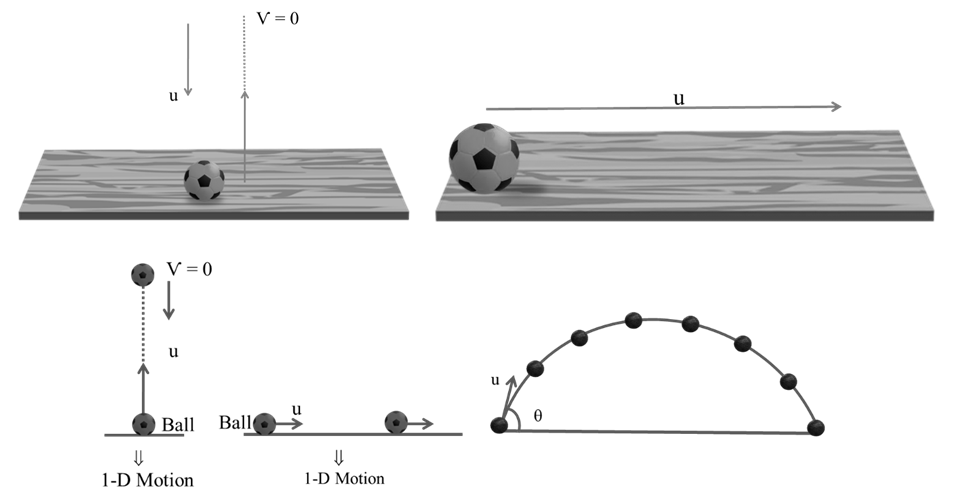
2-D MOTION OR MOTION IN A PLANE Þ
Motion of any object in any of two axis involve (xy or yz or zx)
“Projectile Motion may be 2-D or even 3-D also but in general it is use to be 2-D Motion”
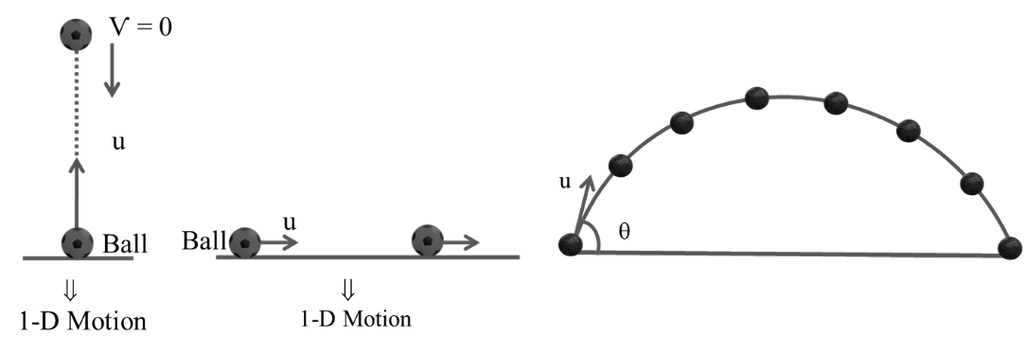
-D PROJECTILE MOTION

VERTICAL MIRROR

Vertical Mirror ® Gravity acts in vertical direction so we can use equations of motion
Time taken by the image of ball going up = time taken going down = t (Let)
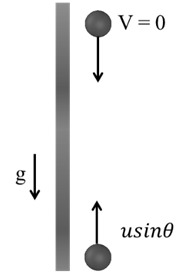
Use v = u – g t
O = u sinq - g t
Total time
![]()
![]()
Now to get Maximum height
Using v2 = u2 – 2g h
(O)2 = (usinq)2 – 2g H
![]()
HORIZONTAL MIRROR
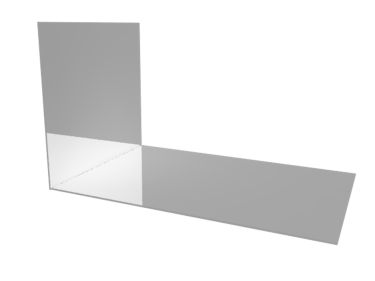
Velocity remains constant so we can not use equation of Motion
Note: Untill any external reason present to change ucosq, like air flow ucosq remains Constant

Now ucosq = Const
![]()
R = (u cosq) T
![]()
Now Sin2q = 2 sinq Cosq
![]()
Now we have
![]()
![]()
![]()
![]()
![]()
CONDITION
“These three results only when can be use if initial point of projection and final point of projection are at same level.
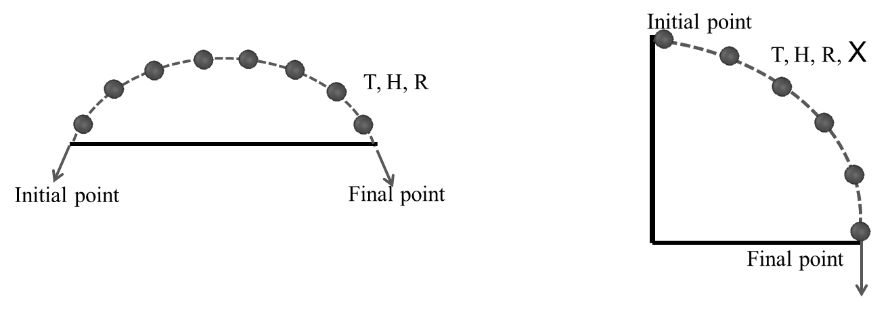
Example: A body of mass m is projected upward with initial velocity![]() then find time of flight, Maximum height attained and range attained by the body (g = 10m/s2)
then find time of flight, Maximum height attained and range attained by the body (g = 10m/s2)
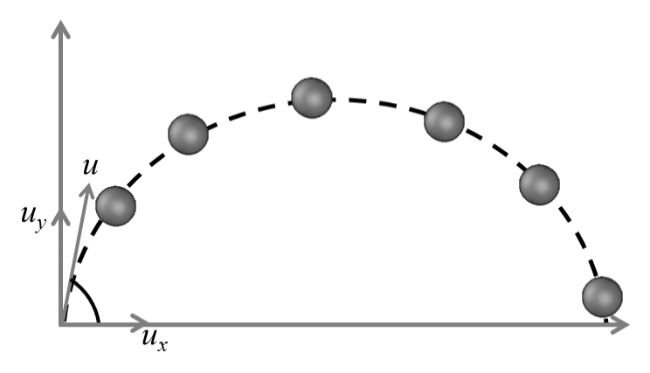
Solution
![]()
![]()
![]()
![]()
![]()
![]()
Maximum range: To get maximum horizontal distance covered by any mass in projectile motion we must have a unique specified angle.

![]()
(Sin2q)max = 1
2q = 90°
q = 45°
To get maximum range angle of projection should be 45 °,![]()
![]()
Note: Here we are neglecting the effect of air resistance. If we Consider air resistance then this angle q should be little bit less than 45°

SAME RANGE
Mathematically there must be two different angle of projection for which we will get same range
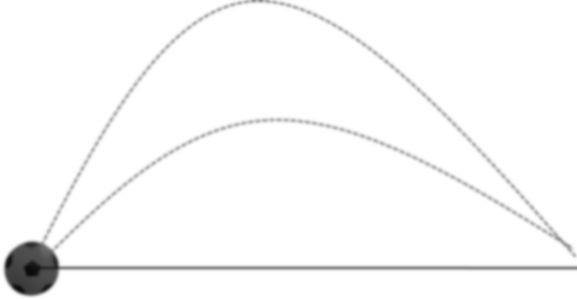
Ball 1
![]()
Ball 2
![]()
Now if we assume
a + b = 90°
then b = 90° - a
![]()
![]()
![]()
If sum of angle of projection is = 90° and initial speed is same then both balls will have same range.
Note: Here in this Case only range will be same not time of flight and maximum height
R1 = R2
T1 ¹ T2
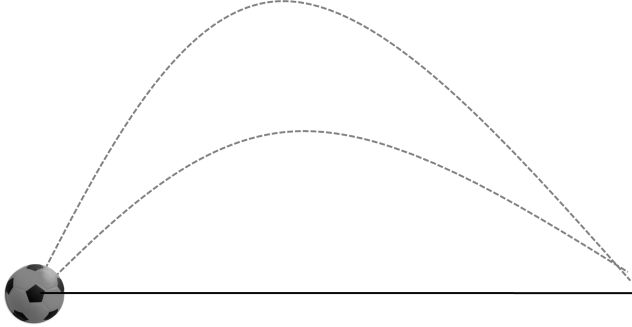
H1 ¹ H2
In case of same range relation of time of flights
Here we know a + b = 90°
Ball 1
![]()
Ball 2
![]()
![]()
![]()
Now
![]()
![]()
![]()
![]()
In case of same range relation of maximum heights
Here again a +b = 90°
Ball 1
![]()
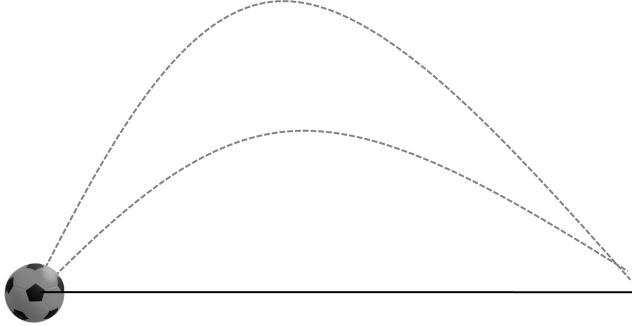
Ball 2
![]()
=![]()
![]()
![]()
![]()
![]()
![]()
![]()
Path of Projectile
TRAJECTORY (PATH) OF PROJECTILE
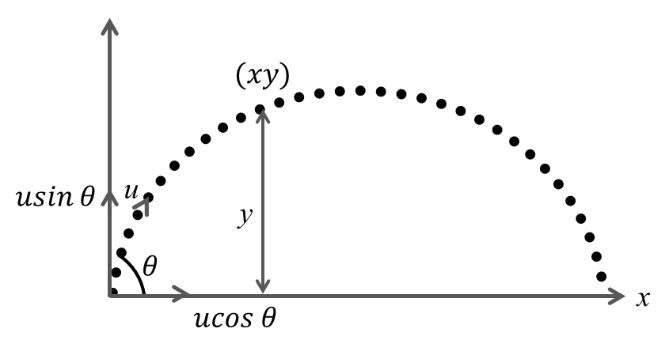
Along y- axis using
![]()
![]()
Along x-axis using
![]()
![]()
![]()
![]()
![]()
![]()
By this equation it can be prove that path of projectile is parabola
OTHER FORMA OF EQUATION OF TRAJECTORY
![]()
![]()
![]()
![]()
![]()
![]()
Projectile Motion when initial point and final point are at different level
Case I Horizontal projection from certain height
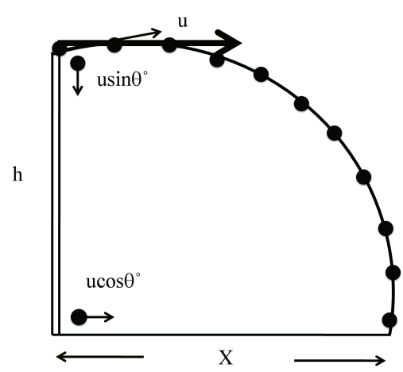
Here angle of projection q = 0˚
In vertical Mirror
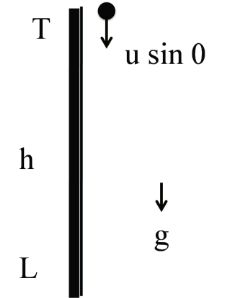
Using
![]()
![]()
![]()
![]()
Time to strike ground in horizontal Mirror
IN HORIZONTAL MIRROR
![]()
=![]()
![]()
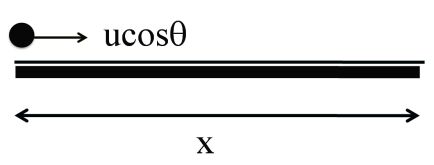
Example: Which ball will strike the ground first
(a) Ball A (c) Ball C
(b) Ball B (d) All Balls will strike simultaneously
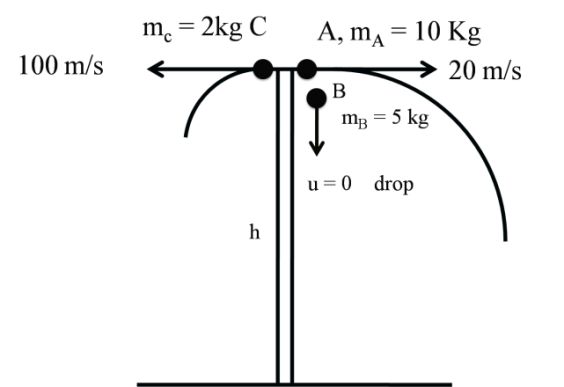
Solution
![]()
![]()
![]()
There fore all three Balls strike the ground simultaneously Answer (d)
Example: A jet fighter plane is flying at constant speed of 360 km/h and jet plane is moving horizontally at a height of 20 km from earth ‘s surface. Jet release a bomb to hit a target on the ground, how much horizontal gap before jet will release the bomb
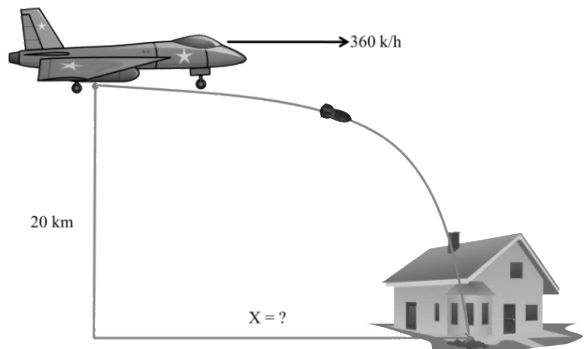
Solution
As discussed above using
![]()
![]()
![]()
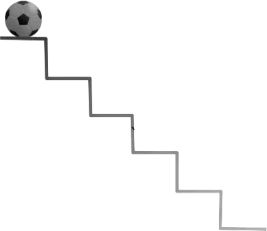
Example: A stair case having each step 10 cm high and 20 cm wide.
If a ball drops in horizontal direction from the top step with 10 mt/sec
in horizontal direction If ball strikes nth step of staire case find the n?
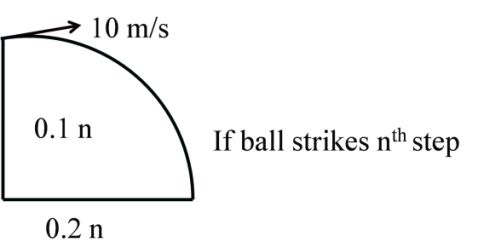
Solution
![]()
![]()
![]()
![]()
![]()
Now make a twist in above question
Every data is same except velocity of ball, if initial velocity not given , and saying what will be minimum initial velocity in above question so that ball hits 50th step
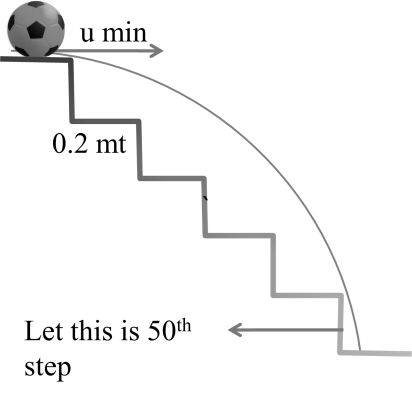
Solution
Now x = 49 x 0.2 mt
h = 49 x 0.1 mt
![]()
![]()
![]()
Projection in upwards and downwards directions
Case II Projection in upward direction with some angle with horizonta
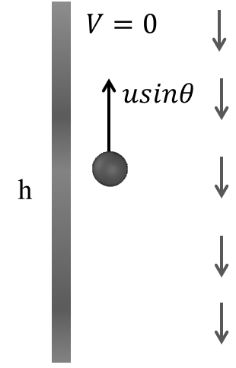
Vertical mirror
![]()
sign convention
![]()
![]()
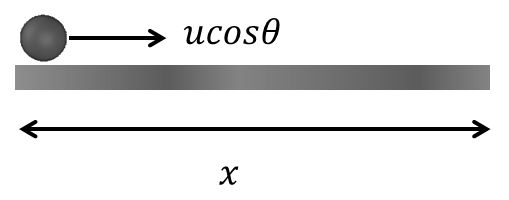
Horizontal Mirror
![]()
![]()
x = (u cosq) t
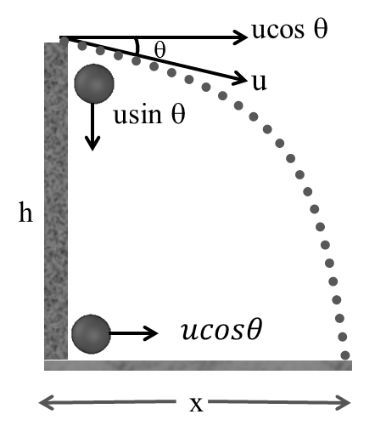
Case III Projection in downward direction with some angle with horizontal
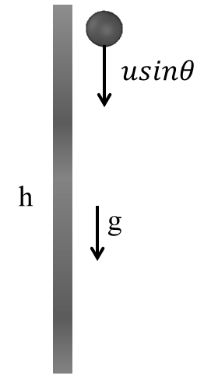
Vertical Mirror
![]()
![]()
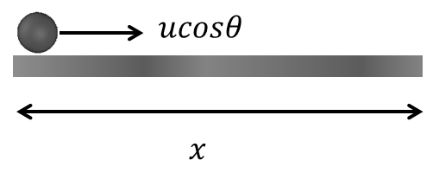
Horizontal Mirror
![]()
![]()
Projectile along inclined plane For Simplicity & understanding
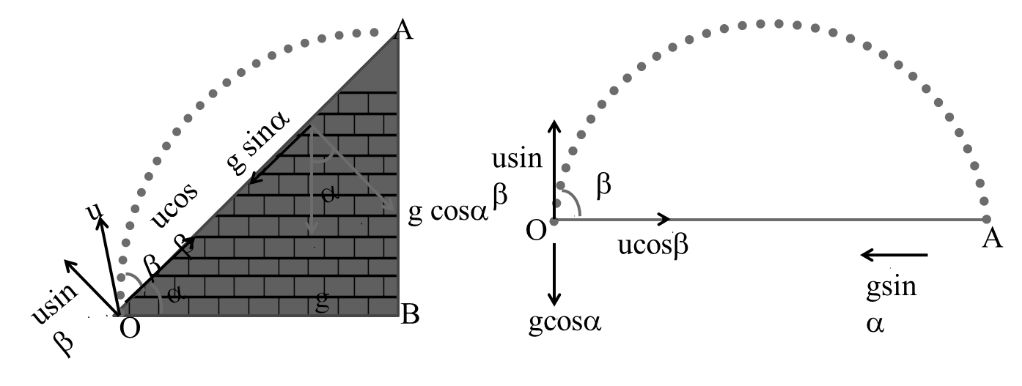
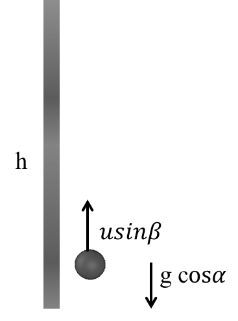
Vertical Mirror
V = u - g t
O = u sin b - (g cosa) t
![]()
![]()
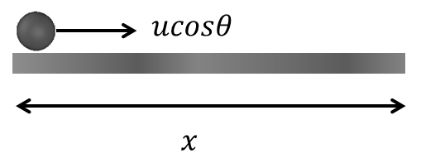
Horizontal Mirror
![]()
![]()
OB = OA Cos a
Special case of Projectile Motion
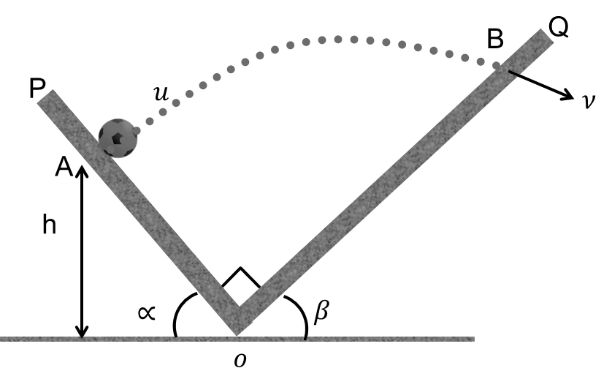
Case I
(i) Time of flight let OQ ® x -axis
OP ® y –axis
ux = u
uy = 0
ax = - g sin b
ay = - g cos b
Now
Vx = ux + axt
O = u – g sin bt
![]()
(ii) Final velocity V
Vy = uy + ay t
V = 0 – g cos b ![]()
V = u cot b
(iii) Height h ![]()
![]()
![]()
![]()
Now
h = Sy sin a
![]()
(iv) Distance AB
![]()
![]()
![]()
![]()
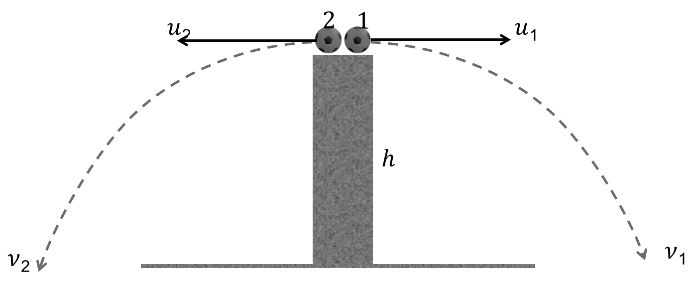
Now
![]()
![]()
![]()
![]()
![]()
![]()
![]()
Case 2
(i) Time after which V1 ^ V2
Ball 1 ![]()
Ball 2 ![]()
Now ![]()
![]()
g2 t2 = u1 u2
![]()
(ii) gap between the ball 1 and ball 2 at the time ![]()
Ball 1 x1 = u1 t,
![]()
![]()
Ball 2
x2 = - u2t
![]()
![]()
Gap between Ball 1 and Ball 2
![]()
![]()
Gap = (u1 + u2) t
![]()
Case 3 Collision of two projectile
![]()
![]()
![]()
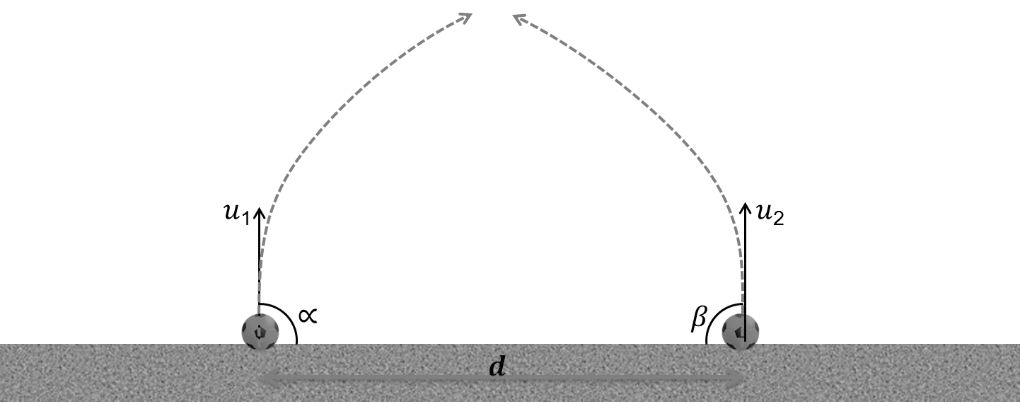

 Kaysons Publication
Kaysons Publication
